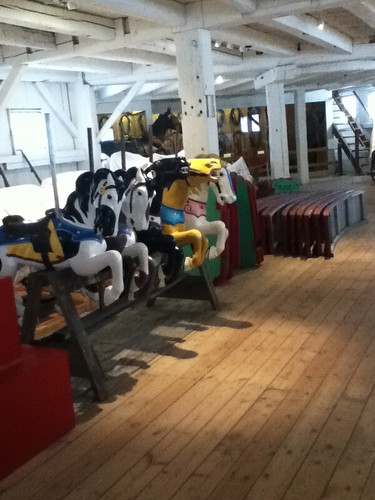I spend a fair amount of time talking about the museum's 1902 Gustav Dentzel Company carousel, quite a rarity in that all decorative elements were acquired together and had never been repainted in its working lifetime. The carousel was originally commissioned by the Fonda, Johnstown, and Gloversville railroad for their end-of-the-line amusement park on the Sacandaga River.
Most of the decorative elements of this carousel have been on display at the museum as examples of the carousel carver and painter's craft since the 1960's. But the painted wood elements, such as the horses, swan boat and giraffes, had been coated with linseed oil as a maintenance procedure for about twenty years here at the museum.
Since 1985, a total of twenty-seven interns studying conservation, hailing from five countries, have come to Shelburne Museum to remove dirty, darkened linseed oil from the painted surfaces of the menagerie, and rounding boards from this carousel, Since 2003, these internships have been funded through an Adopt-a-Carousel initiative. In return for funding an intern's stipend, donors have the honor of choosing and naming a carousel animal that intern will work on. This June a twenty-eighth intern will join us for eleven weeks to clean the 31st animal of the 40 animal menagerie and one of the rounding boards.
Most of the decorative elements of this carousel have been on display at the museum as examples of the carousel carver and painter's craft since the 1960's. But the painted wood elements, such as the horses, swan boat and giraffes, had been coated with linseed oil as a maintenance procedure for about twenty years here at the museum.
Since 1985, a total of twenty-seven interns studying conservation, hailing from five countries, have come to Shelburne Museum to remove dirty, darkened linseed oil from the painted surfaces of the menagerie, and rounding boards from this carousel, Since 2003, these internships have been funded through an Adopt-a-Carousel initiative. In return for funding an intern's stipend, donors have the honor of choosing and naming a carousel animal that intern will work on. This June a twenty-eighth intern will join us for eleven weeks to clean the 31st animal of the 40 animal menagerie and one of the rounding boards.
My colleagues and I have written articles for the conservation literature about how our cleaning protocols for these animals have developed over the years, created slide shows of the treatment process on Flickr, and administrate a Facebook page to share the carousel's history and updates of our progress.
Well, its high time that I filled you in on the behind-the-scenes action regarding the other carousel - the one that sits in front of the Circus building. Made around 1920 by the Herschell-Spillman Company of North Tonawanda, New York, this model was designed to be disassembled and reassembled for use in a traveling carnival. Unlike the Dentzel carousel, the Herchell-Spillman came to the museum stripped of its original factory paint and was later coated in bright colored "park paint". In contrast to the Dentzel carousel, this one retains every part of its original function. Each fall, members of the Buildings and Grounds departments disassemble the carousel for winter storage and every winter the Buildings department repairs and repaint a number of horses so that museum visitors can fully enjoy this vintage carousel come spring.

Parts of the Herschell-Spillman carousel stored for the winter
Painter Justin Mayo is in his fourth year here at the museum and in that time he's worked on every horse and the two chariots on the Herschell-Spillman. I talked to him a bit about the horse he's currently working on, one that he worked on his first winter on the job.



When this horse came into the paint shop, Justin noted that the carved wood tail was really wobbly. On closer inspection he found that it was only being held in place with a few long nails into a mass of wood filler and deteriorated wood within the horse's body. Working with Chip Stulen, who directs the Buildings department, Justin and Chip made the tail more stable by removing the old repair and replacing it with a carved wood plug. A dowel connects the tail with the repaired sections within the body. Gaps are then filled and primed and the horse will be repainted.

This horse tail should be better able to withstand the demands of use. Contrast that wooden tail with the 109 year old horsehair tails on the Dentzel carousel horses which don't withstand much handling at all.
Similar to the reports we keep on the work we do in the conservation lab, Justin keeps a notebook which contains images of each horse and chariot when it entered the museum in the 1980's as well as a log of the work that's done on each horse. He records the paint colors used and what repairs were undertaken so that we have a record of who did what and when. This helps him to match paint colors across the animals, presenting a cohesive appearance, and to prioritize work for the next winter.
In short, what underlies our work is the same. We each aim to preserve a carousel that you and your families can enjoy, albeit in slightly different ways.

Thank you. I love reading about carousel animals and have a particular love of the Herschell horses. I've had the pleasure of living near two Herschell carousels. Yours, and the one in Greenport, NY. Of course you take excellent care of yours, and its great to read about the process. I've blogged about Herschell horses, and photographed them. You can see what I've written at my blog here http://seesaw.typepad.com/blog/2008/04/carousel.html.
ReplyDeleteLooking forward to the Shelburne Museum opening in the Spring. Thanks, your neighbor in Burlington, Liza.
Nice round-up of carousels. Thanks for sharing that, Liza.
ReplyDelete